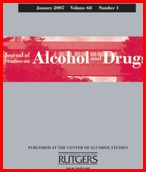The current study examined the distinction between primary and secondary depression among substance use patients to test whether the primary depressed subgroup presents to treatment with a unique profile of clinical and vulnerability characteristics.
The heterogeneous sample comprised 286 individuals (76% male) with alcohol and/or drug abuse or dependence (according to criteria from the Diagnostic and Statistical Manual of Mental Disorders, Third Edition, Revised) across four treatment outcome studies conducted at the alcohol research center at the Rutgers University Center of Alcohol Studies. Participants were classified as having comorbid lifetime history of primary depression (21%), secondary depression (24%), or no depression (55%).
Participants in the primary depression and secondary depression groups were comparable in severity of substance use, and both of these groups had more severe substance use problems than the no-depression group. The primary depression group presented with more severe depression histories, higher levels of current depressive symptoms, and higher rates of additional Axis I comorbidity at treatment entry. In terms of vulnerability indices, the primary depression subgroup had a uniquely high family history risk for major depressive disorder; underlying personality vulnerability to depression was also evident in the primary depression group, with higher neuroticism and lower extraversion relative to secondary depression patients.
The findings suggest that careful assessment of lifetime depression symptoms vis-à-vis substance use history and severity yields important information identifying the primary depression subtype of substance use patients as a group with a unique and more severely affected clinical presentation of depression and other Axis I psychopathology relative to secondary depression patients.
Effectiveness of substance use interventions may be augmented with depression treatment for primary depression patients, given their more severe clinical presentation and vulnerability characteristics.
Request Reprint E-Mail: amycohn@rci.rutgers.edu
